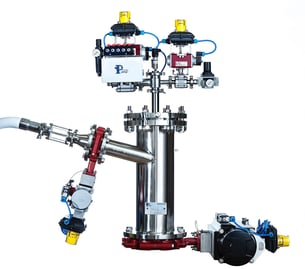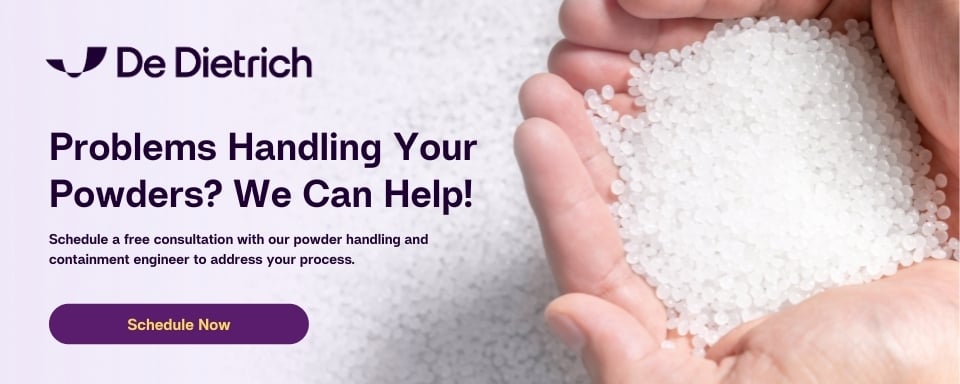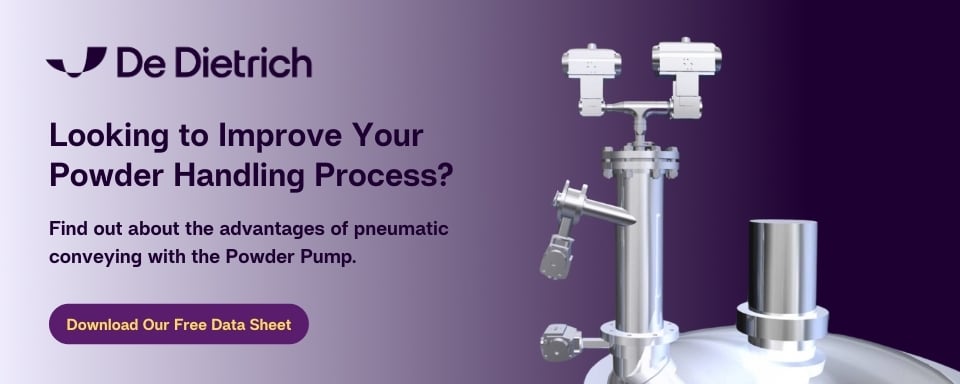Keeping your Facility Clean and Safe with Pneumatic Conveying

Cleanliness and safety in the workplace are crucial in pharmaceutical, fine chemical, food, and other processes that involve transferring powder from one place to another. Any time materials need to be moved it brings up potential housekeeping issues and risks to the operators. But how does one manage to maintain sanitary work conditions to uphold the integrity of their product while maximizing operator ergonomics and minimizing negative influences on the environment (while factoring in productivity, cost, etc.)? That’s a lot of objectives to juggle all at once, especially when the best solution for one problem isn’t always the best for another aspect of the application. Fortunately, cleanliness and safety go hand in hand, as a hygienic atmosphere contributes to a safe working environment for employees.
Pneumatic transfer is a technology that utilizes vacuum conveying and/or pressure conveying to move material. When incorporated into a system, it can help your process operate in an innovative way that promotes worksite health and employee well-being while preserving the hygienic environment of your process. Here are the benefits of pneumatic conveying regarding plant and equipment cleanliness and employee health and safety:
Let’s talk about Cleanliness
It is a common practice to manually transfer material into a vessel. Surprisingly this occurs in some of the most modernized workplaces. This involves operators lifting and dumping containers of powder directly into the reactor. With mechanical equipment there is more automation involved, but the cleaning of conveyor belts poses a constant problem that is difficult to solve due to particles adhering to the belt as well as material build-up on the rollers.
Most pneumatic conveyor designs, on the other hand, create a closed system – a system that prevents the product from becoming airborne and entering the environment. This equates to many things, but basically:
- Your product isn’t contaminating the environment (critical if your product is hazardous)
- The environment isn’t contaminating your product (especially important if your product is oxygen sensitive)
Regardless of your process being batch or continuous, the creation of a closed system is the surest way to keep your facility, employees, and product clean. By sustaining a dust-free environment exterior contaminants are eliminated as is the need for expensive personal protective equipment (PPE). The removal of these contaminants will not only improve your systems cleanliness, it will also reduce external corrosion and thus prolong the life of your equipment.
Powder handling solutions designed by DDPS incorporate the Powder Pump, an apparatus that features an easily accessible dust filter element to enable hassle-free cleaning, inspection, and change out. This user-friendly design makes it more manageable to uphold a good housekeeping regime, plus maintenance personnel and operators can appreciate the significant decrease in dust and powder spills. Additionally, less labor is required to clean and maintain cleanliness so the cost-performance ratio of the system is improved, providing significant savings over other transfer methods.
Bottom line: Whether it is housekeeping requirements for sanitation or general cleaning between batches, pneumatic transfer systems need less maintenance and offer a cleaner way to transfer than manual and mechanical methods.
Let’s talk about Safety
If safety is your utmost concern, pneumatically conveying powder is an extremely reliable method of transfer that will improve the overall well-being of your employees. It eliminates the risk of operator back injury caused by lifting heavy powder containers to manually dump powder. There is also no risk of employee exposure to hazardous chemicals such as nitrogen and solvent vapors thanks to the closed system that is maintained during the process. And since powder charging can be done from a distance, operators don’t need to get close to the reactor while it is running, further increasing safety and efficiency.
Unlike manual and mechanical transfer methods that require open manways and pauses in operation, pneumatic conveying allows you to charge a vessel at any time without disrupting the process. The ability to charge powders without opening a manway gives you the ability to not only save time but also to charge with the vessel under pressure or vacuum, as well as with solvents already in the vessel – and all while retaining an inert atmosphere. Although many applications involve nontoxic powders, pneumatic transfer enables the conveying of carcinogens, oxygen or skin sensitive and explosive powders safely. Whatever the type of material you have in your process, it’s reassuring to know they can be moved safely.
Another important topic on the subject of safety is contamination. Contamination can mean one of two things in a process. Depending on the properties and characteristics of the material being transferred, there is the concern of contaminating the product with exposure of environmental elements (e.g. oxygen, human contact) that can have an adverse effect on the product’s purity. The flip side of that scenario is the risk of contaminating the environment with the product, in the case of hazardous or explosive materials. When it comes to exterior contaminants, product residue that comes in contact with the exterior of the equipment can create an unhygienic situation which, over time, can become a serious problem that negatively impacts the safety of the work area as well as the performance of the equipment.
If you feel that there was some redundancy in this post, that’s because the subject of cleanliness and safety in terms of material handling are virtually one in the same. Creating a safe, healthy, and clean work environment is critical to protecting your employees. A facility is not safe if it’s not clean, and vice versa.
Powder Handling Solutions from De Dietrich Process Systems eliminate the need to manually handle powders and minimizes potential hazards by using pneumatic conveying technology to create a dust-free, closed system that enables the transfer of raw, intermediate or finished products in a contained manner from a powder container, such as a big bag station, to a reactor or other secondary piece of equipment. The ability to maintain an inert atmosphere and separate entrained gas from solids via the system's internal dust filter element allows the solids to be retained inside the Powder Pump body. This is beneficial for the cleanliness of your facility, the health and safety of your employees, and the overall optimization of your process.
For for more information about DDPS powder handling technology contact us online, or for a free assessment to see how our powder handling solutions can be incorporated into your process fill out our Powder Handling Application Questionnaire.

